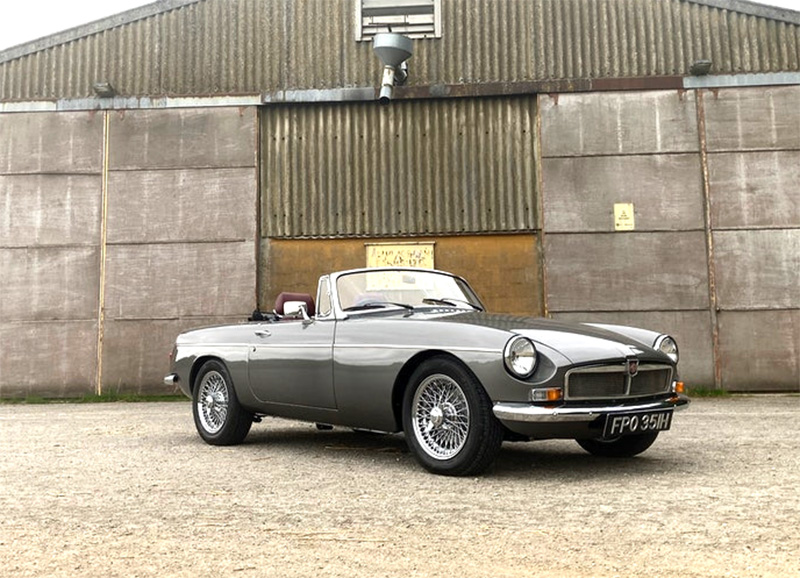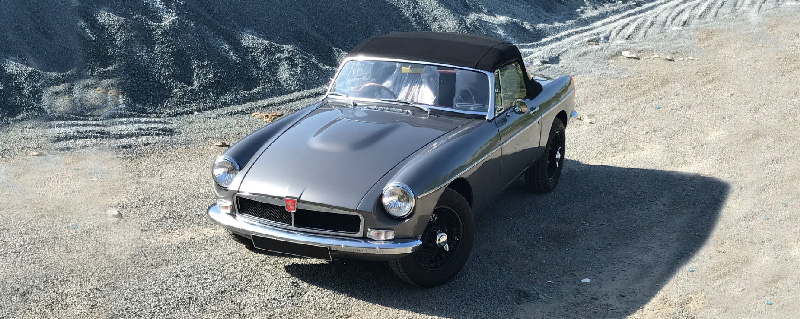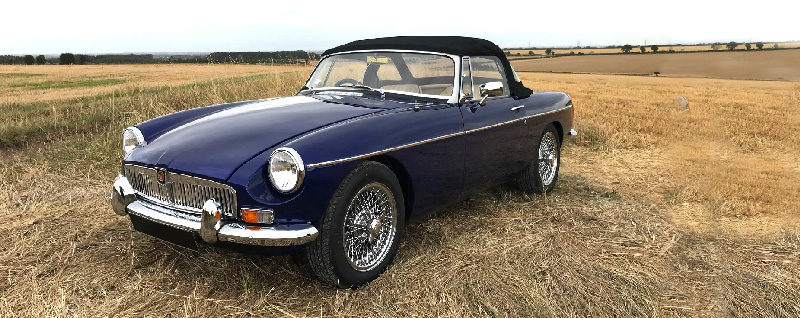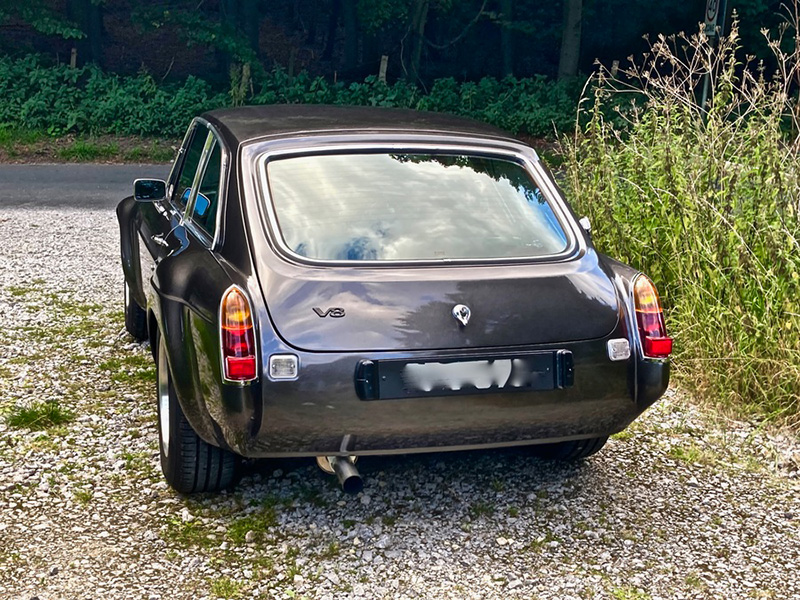MGB History
Enjoy this journey into the history and the specification changes of the MGB
![]()
Presentation
Written by Terry Lucas.
A drivers car
The MGB, for many, the affordable classic sports car which in theory should need no introduction, I imagine we have all seen or heard, sat in, driven or stared lovingly at an MGB at some point in our lives.
From early experiences of driving to fond memories of friends or relatives owning one to the all too familiar tale of parting ways with a cherished MG to make way for a family-friendly car with more seats or as a deposit for a new home.
People interested in 60’s & 70’s cars will at some point have been involved to some extent with an MGB, and this is where our story begins.
I hope you enjoy this journey as we delve into the history and the specification changes of the MGB, the records which were kept, in the 60’s and 70’s were very different from today. Therefore we are somewhat reliant upon information supplied when pen and paper ruled and long before computer systems took over.
MGB HISTORY MAIN CONTENT (direct links)
- A drivers car
- The origins of the MGB
- The Launch of the MGB
- Chronology
- A brief history of MG and its owners
You can read on our site a Mechanical Brief History (Engine, Gearbox, Ignition system…) about MGB GT here.

A drivers car
Quite simply timeless
The MGB was and still is a drivers car. Unlike modern cars, they have to be used and driven to fully appreciate their charm, these cars have a real soul and when used give you the feeling of genuine interaction with a machine which very few, if any modern cars can offer.
As with many things they are often undervalued at the time and the real beauty and worth of them goes unnoticed until much later in life when you sit back and appreciate what they were and what fun one had owning and driving a real iconic game-changer of a car.
The MGB saw many changes over the years, some to merely update the car and keep it fresh and other changes more radical for the various markets they were destined for.
Syd Enever
The car’s designer Syd Enever managed to create a car which was much more robust and stiffer than its predecessor the MGA, this helped the handling of the car and made it a very sturdy and safe vehicle in its time.
Developments
As with nearly all car production runs, they evolved over some time, the MGB was no different.
The changes to the MGB were not only to improve the car but also to keep pace with the general public’s requirements.
Regulations
To keep up with regulations, this saw the introduction of the rubber bumper model with the increased strength and new materials they were used mainly for the North American market.
These were to keep in line with more stringent USA regulations that were imposed on what was the MGB’s biggest market.
I have driven many MG’s from very standard factory specification cars to highly modified examples, but they all portray the same characteristics from this much loved and respected model of simplicity, it has a sure-footed and predictable feel making you confident about the capability of the car.
A replacement for the MGA
The MGB was introduced in 1962 as a replacement for the beautiful but dated MGA, the aim was to update and build on the predecessors success and include more features to keep pace with other car manufacturers of the time and also to make the car more usable on a daily basis.
The whole design of the car was radically changed, not just with the monocoque body but also with the addition of wind up windows and a more powerful engine and improved gearbox.
MG had to devise something to rival its competitors, and with that, the MGB was born.
Initial reaction
Initial reaction was good, but not even MG was aware of the impact that their new model would have on the company, and how it would become one of the best-loved British sports cars of its era, still popular today, the car has a huge following.
Its ease of driving along with the attractively designed bodywork with the chrome strip that runs the full length of the body gives the MGB its defining look, which is quite simply timeless.
Over the full production period of the MGB from May 1962 until it was stopped in October 1980 just over 512,000 cars were built with a large proportion destined for North America.
MGB Roadster
The MGB Roadster was unveiled first, it was then followed by the GT model with production starting in September 1965.
Both cars were easily recognised, the MGB GT version, a Coupe, shared many of the same mechanical components but with altered body panels to supplement the flowing body lines.
The GT was a more practical and usable example having the added benefit of a small rear seat for occasional use if needed, providing someone was prepared to squeeze into this tiny area.
The origins of the MGB
There was a great deal of room for improvement
Whilst the exterior style of the new roadster, known by its BMC project number of ADO23, was mainly completed by 1959, its mechanical details were still work in progress.
Both Abingdon and BMC management hoped to make the ADO23 a much more sophisticated package than the MGA.
Abingdon had high hopes for the project which involved updating the MGA’s antiquated suspension.
The MGA’s front suspension was the same as the Y-type saloon, with old-style lever shock absorbers and simple live rear axle on leaf springs.
Several engineers and many drivers criticised the MGA’s handling especially at speed. Since the rear springs had full responsibility for the axle location, they were very stiff. This was fine on a smooth track, but not so great on everyday roads where the harsh suspension and high unsprung weight caused the ride to be too firm and quite uncomfortable.
There was a great deal of room for improvement and to make its successor a user-friendly vehicle that it had to be to ensure it was a success from the start things had to change.
John Thornley, the General Manager of MG at the time very much wanted the ADO23 to be ready before the end of the ’50s, but with various delays in the construction of the first full usable prototypes, it was not ready until the spring of 1960 and coupled with the fact that they were not ready for full testing until autumn of that year the timing of the cars were well behind the anticipated schedule.
During this time Abingdon launched the MGA 1600 Mk 2 to keep interest alive while work continued on the MGB.
As John Thornley had initially suspected the MGA sales lost ground rapidly in the early 60’s as many buyers veered towards its rivals such as the Triumph TR4, and it was apparent that the replacement had to be ready soon.
One of the last MGA roadsters, the MGA 1600 Mk 2 was Introduced in June 1961 and was given an increased engine size to 1,622cc producing 90 Bhp along with a few minor tweaks and alterations. However, this could not win back enough new buyers, and MG knew they had to act quickly and introduce the all-new replacement.
The spruced-up MGA was not a great sales success, for all the reasons they already knew and were trying to remedy with the MGB.

The Launch of the MGB
A desirable proposition for many
The MGB was launched in 1962 and was hailed a great success.
It was aimed directly at the US market; the car was praised not only for its modern design but also for the improved space inside and the notable upgrade the engine and gearbox enhancements gave along with better weather gear and overall ease of use.
It had some big boots to fill taking over from the MGA. Still, it looked as though MG had pulled it off with journalists and buyers all giving positive reviews, the comments proving the bold move of making the car a stronger and comfortable machine in comparison to the MGA had paid off.
Sales
The sales figures proved the MGB was a hit and continued showing no signs of slowing down for the first few years, the introduction of the GT in 1965 cemented its status as a desirable yet affordable sports car of the ’60s.
Not until 1967 did sales start to slow, this was a trend that lasted a few years until the refreshed model was introduced in 1970.
Refreshed model
This brought new buyers who bought into the updated offering even if the die-hard enthusiasts were not as supportive. They did not like the idea of vinyl seats and rubber-faced over-riders and a completely revised recessed front grille, all in all there were mixed reactions.
Overall the MGB was a commercial success, quickly overtaking the early MGA for sales. The MGB’s 25,000 plus annual sales were fairly modest in comparison to some, but it was the best-selling model Abingdon had ever offered. It showed they were still capable of producing a car to compete with its rivals.
A desirable proposition for many
A major factor of the MGB popularity was the price. This was a desirable proposition for many, especially when compared to the likes of Jaguar and Triumph. In the UK, the price started at £949, £60 cheaper than a very basic Triumph TR4.
Fortunately for British car buyers, the Chancellor of the Exchequer cut the tax rate significantly just weeks after the MGB’s introduction, so by the 1964 model year, the advertised price had fallen to £836 this included purchase tax even though the base price had not changed.
Sold abroad
Just like the MGA, most MGBs were sold abroad. North America taking the lions share with the bulk of production, but the MGB also sold well in other countries. To avoid import charges, MG developed CKD (completely knocked down) kits which were to be assembled locally in Ireland, Belgium and Australia, more than 9,000 MGB roadsters were built down under between 1962 and 1972.
Significant changes
The most significant changes for the MGB occurred in 1974 when, whilst still retaining its overall silhouette, the shape was marred by the change of larger black rubber bumpers, for many this was the decline of the MGB as we know it. The major factor for this addition was the North American market which pretty much dictated what was going to happen with the MGB as it was the largest single buyer of the car.
Raising the ride height by one inch and removing the shiny chrome bumpers with heavy and large black rubber offerings was to enable the car to comply with stricter crash regulations for the US.
The car was too long in the tooth to redesign completely, and a new model was out of the question, so the only way forward for British Leyland was to modify and adapt what they had.
Late 70’s
In fairness, it still sold reasonably well until the late ’70s and figures remained fairly consistent.
Still, the car that had essentially the same body shell and lines for nearly two decades was showing its age. It was starting to look dated in what was becoming a hot hatch market.
Changing tastes
Tastes were changing and was reflected in the likes of the Mk1 Golf GTi.
There was a movement away from two-seater sports cars lean towards a larger more refined market for people who wanted a practical hatch with sportier credentials.

Chronology
September 20, 1962 MGB officially introduced to the world
A quick view of main changes during the production run
60’s
May 1962
Mark I – First production car completed. (GHN3-101) 18G engine.
July 1962
Last MGA produced (101,081 produced)
September 20, 1962
MGB officially introduced to the world.
February 1963
Overdrive now offered as an option; factory hard-top provided as an option.
August 1963
1964 model year. 18GA replaces 18G engine.
September 1964
1965 model year. 18GB five bearing engine now fitted, electric tachometer fitted.
March 1965
The Fuel tank was increased from 10 to 12 gallons and supported by bolts rather than straps. Door handles changed from pull handle to push-button type.
September 1965
1966 model year. The MGB GT was unveiled (first production GHD3-71933). Salisbury axle introduced on the GT models only.
November 1966
1967 model year. (GHN3-108039) Front anti-roll bar now standard fitment on tourer.
March 1967
Reversing lights standard on roadster cars from March
April 1967
Reversing lamps now fitted to GT and became standard on all cars, Salisbury rear axle is now a standard fit on the tourer.
November 1967
1968 model year – (Mark II), 18GF engine. All-synchro gearbox fitted to the MGB, alternator and negative earth electrics fitted, pre-engaged starter now used.
October 1968
1969 model year, 18GH engine, (GHN4-158371, GHD4-58231). (indicator lamps closer to grille opening).
October 1969
1970 model year – recessed black grille, BL badge on each front wing just in front of the doors, rubber inserts in bumper over-riders, Vinyl seats used, smaller steering wheel with three drilled spokes, heater standard on both models, Late 1969 Aluminum bonnet replaced by steel.
70’s
1970 model year – recessed black grille, BL badge on each front wing just in front of the doors, rubber inserts in bumper over-riders, Vinyl seats used, smaller steering wheel with three drilled spokes, heater standard on both models, Late 1969 Aluminum bonnet replaced by steel.
August 1970
1971 model year, type 18GK engine. Ventilation and heating improved, new interior light, automatic boot and bonnet stays replace rod-style props.
May 1971
250,000th MGB built
August 1971
1972 model year, 18GV engine, HIF-4 carbs, radio console and armrest with storage and ashtray facility fitted.
August 1972
1973 model year. 18V engine, wiper arms now black, heated rear window in GT, revised grille with black mesh.
August 1973
1974 model year, 18V engine, automatic gearbox withdrawn, GT withdrawn form California market.
September 1974
Rubber Bumpers introduced, chassis raised 1.5″, single 12-volt battery.
December 1974
GT withdrew from N. American market.
June 1976
1977 model year. Electric radiator fan (two for North America and Japan), thicker front onto roll bar, rear unit roll bar becomes standard, gear lever overdrive switch, sealed cooling system,
May 1978
1979 model year. Radio speakers mounted in both doors.
March 1979
Start of North American “Limited Editions”. 6682 LE’s built for North America
June 1979
1980 model – Identification numbering changed to comply with US VIN systems. 80 mph speedometer, headlight rims notched for easier adjustment, front suspension cross member modified in anticipation of fitting “O” series engine. (501001).
80’s
October 22, 1980
Last two MGBs completed (523001, 523002 respectively).

A brief history of MG and its owners
Discussion remains
Company’s name
The company’s name is thought to have originated from the initials of Morris Garages, discussion remains as to when the MG Car Company initially started, although the earliest cars to use the Morris and MG badges appears to be around November 1923.
The MG Octagon was first registered as a trademark by Morris Garages on May 1 1924, with its 90th anniversary celebrated in 2014.
The very first cars were re-bodied Morris models that used the coachwork from Carbodies of Coventry.
Premises
Morris Garages built these in premises in Alfred Lane, Oxford.
Demand soon built up which saw a move to larger premises in Bainton Road in September 1925. They were now sharing workshop space with the Morris radiator works.
Further expansion did lead to yet another move to a separate factory in Edmund Road, Cowley, Oxford in 1927. It was near the main Morris factory, and for the first time, it became feasible to include a proper production line.
In 1928, the company had yet again grown. It was also big enough to need an identity separate from the original Morris Garages, to help build on its success and grow the brand, the MG Car Company Limited was established in March of that year.
During October for the first time, a stand was taken at the London Motor Show.
Once more space ran out, and another search for a more permanent home led the search to an old leather factory in Abingdon, Oxfordshire.
In 1929 that they were able to lease a large section and then gradually taking over more space in time until production finally ended there.
Ownership
MG was owned initially by a Mr. William Morris; MG was sold during 1935 to Morris Motors which was a member of the Morris Organisation, later called the Nuffield Organisation.
In 1952 MG, Morris Motors Ltd and the Austin Motor Co were merged to form the The British Motor Corporation Limited.
The service manager John Thornley took control as general manager, and under his influence, he navigated the company through its best years until he retired in 1969.
Under the umbrella of the British Motor Corporation, several MG models were merely re-badged and engineered versions of other established marques, with the main exception of this rule being the MG sports car division.
BMC also took over Jaguar Cars in September 1966 and in December BMC changed its name to British Motor Holdings it joined forces with Leyland Motor Corporation in 1968 to form British Leyland Motor Corporation (BLMC).
Then following partial nationalisation in 1975, BLMC became British Leyland which was eventually known as BL.
British Leyland’s management team and engineering staff were mainly sourced from the former Leyland organisation, which included MG’s closest rival Triumph.
BL’s divisions
Triumph was also grouped into BL’s Specialist Division, alongside Rover and Jaguar, MG was retained with the former BMC marques in the Austin-Morris Division, which stuck to its job of making high volume family cars.
While Triumph launched new models like the TR7 and the Dolomite, during the Seventies. MG was not producing anything new of real interest apart from the now legendary V8 version of the MGB.
The MG operations were profitable; however, the rest of the Austin Morris division was showing huge losses and funding was made available only for mass-market models. This left MG with minimal resources to improve and expand its line up which was by then becoming outdated.
Closure of Abingdon
With the closure of Abingdon on October 24, 1980 caused by the cutbacks, BL saw this as the only way forward as the rollercoaster ride of the 1970s had taken its toll on the company.
The very last car built at the factory was the MGB, when the factory closed it was left abandoned for a while, and it was later decided that the company would not produce a replacement for the MGB or MG Midget.
Under the control of British Leyland, many plants were closed.
Still, none created such a backlash from workers, customers and all associated with the factory than this one. It was for many years an iconic place that many felt so passionately about and had such a long history of what was a great British industry with real heritage.
Back to life
During 1982, the marque was brought back to life but under the guise of high-performance alternatives of the Metro, Montego and Maestro. The MG Metro continued to be produced until 1990. From then the Rover brand took over, but within a year the MG versions had ceased production.
During 1992 the MG RV8 became available, this used the basis of the MGB body shell but with more prominent wheel arches and the use of moulded modern bumpers but this time with a 3.9 V8 engine which the MGB Roadster had always cried out for.
A limited number of 2000 cars were produced, and around 75% were destined for Japan, sales were slow, but the car did come with a hefty price tag of £26,000 which was a lot on money at the time. It had a lot of competitors in that market and much more appealing and potentially more competent.
1995 saw the birth of the MGF which was the first all-new MG since the MGB.

Bespoke MGB
59 Main Street, North Ferriby, East Yorkshire
HU14 3QR
Email: lucapatroni@me.com
Tel: + 00 44 333 022 0135
